The Zebra Plant (Haworthiopsis) is native to South Africa. All the 18 Zebra Varieties are very durable. Zebra plant care is easy. Perfect choice for a houseplant beginner.
Latin name for this plant is Haworthiopsis. It was formerly in the Haworthia genus. In 2013 the new genus Haworthiopsis was created . The zebra plant became part of it.
Plant enthusiasts and even nurseries still call it Haworthia. I recently purchased a Zebra Plant labeled haworthia.
Zebra Plants are related to aloe vera. Like aloe vera, Zebra plants Hold moisture in their fleshy spiky leaves to sustain them through periods of drought. Rather like a camel hump. 🙂
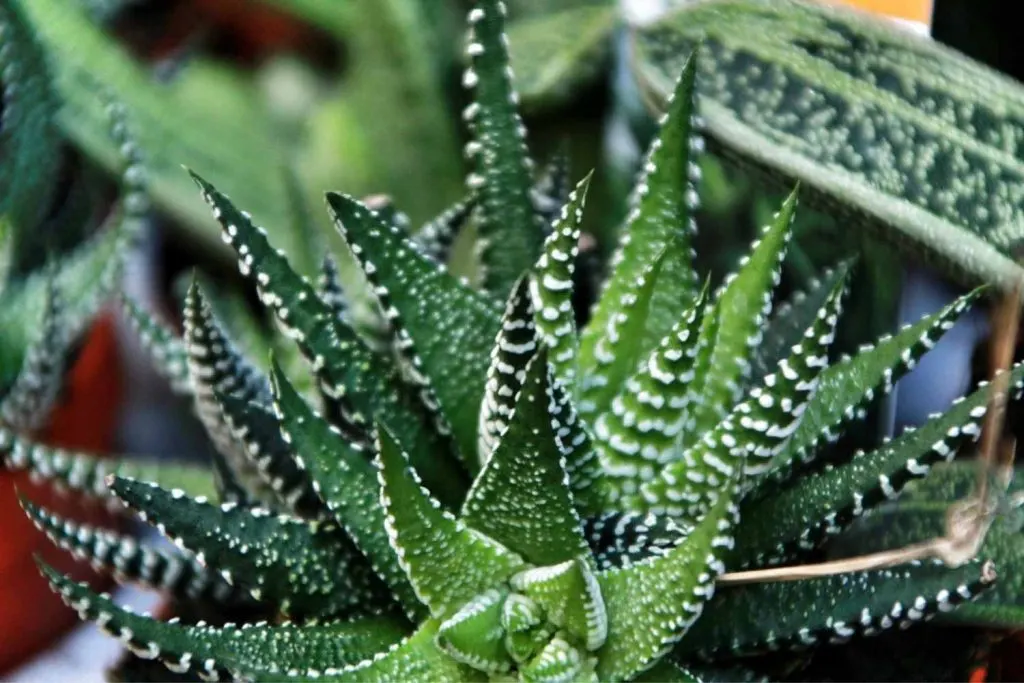
I have the the Super Zebra. White bumpy tubercles grow all around the leaves. The leaves grow to a fine point at the tip.
The eye catching spiky architecture of the green leaves with the contrasting white tubercles stands out. The rosette shape of this striking small plant fits politely into a round pot.
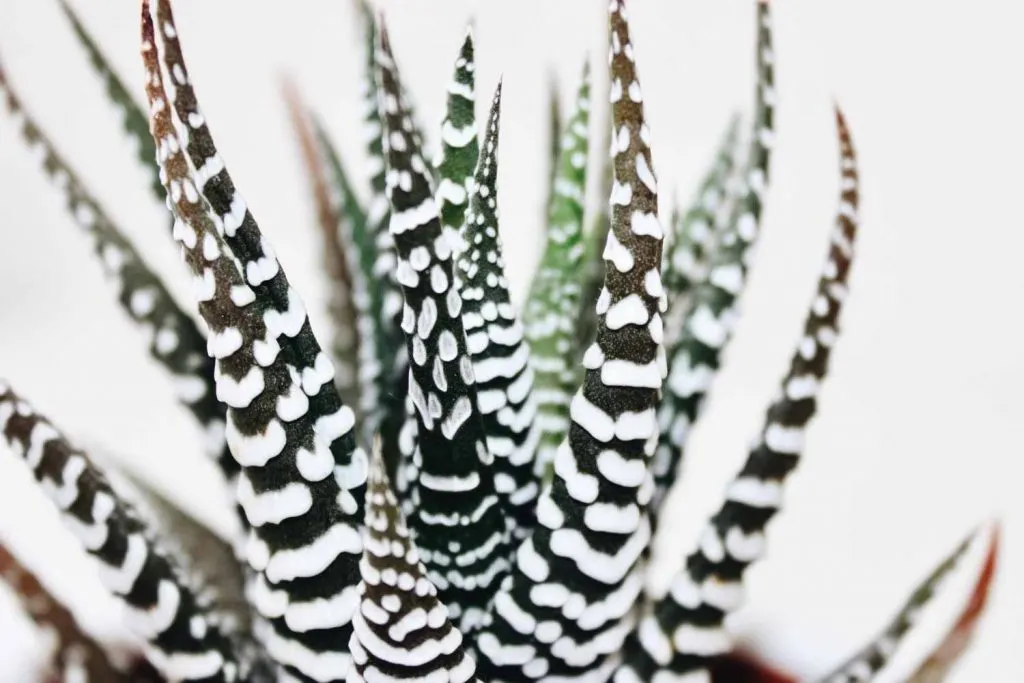
This is a slow growing succulent. Choose a 4 inch pot you enjoy. It will be a perfect size to sit on your window sill and bask in the (bright indirect) light and air.
Haworthiopsis fasciata zebra plant leaves have a smooth green topside and tubercles of white on the underside of their leaves.
Sourcing Haworthia Zebra Plants:
You will likely find some varieties of Zebra plants in your local garden centers. These are popular plants and often available.
However, if you are looking for a particular type of Haworthia Zebra, shopping online may be your easiest option. We recommend ETSY to find a wide selection of these cute succulents.
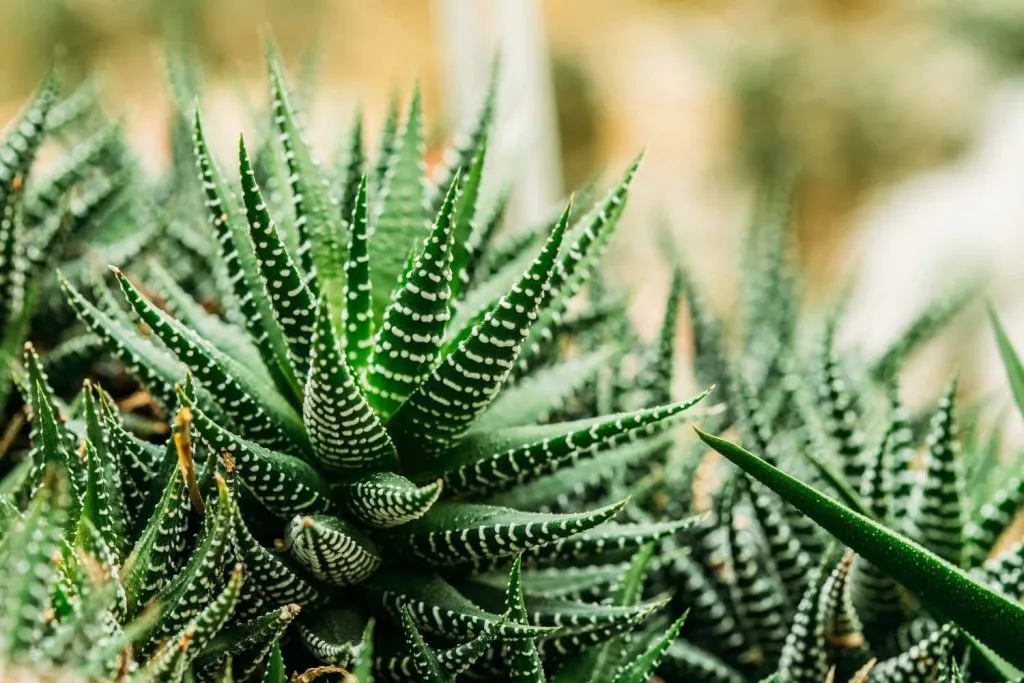
Zebra plants are naturally green with white tubercles. Variegated forms(alba) are lighter.
Haworthiopsis do get brown dried tips. This is normal for this plant. Just cut them off if they bother you
Zebra Plant Toxicity:
Zebra plants are safe for cats, dogs and people. If your kitty develops a taste to the tips of those attractive spines, it won’t hurt them.
And… toddlers and pets are really not good for your plants. 🙂
However, it’s always best to keep even non toxic plants away from young children and curious cats and dogs. The soil and fertilizers may NOT be safe for pets and children.
Flowering:
Zebra plants flower easily in the outdoors. Indoor conditions are often not ideal for flowering.
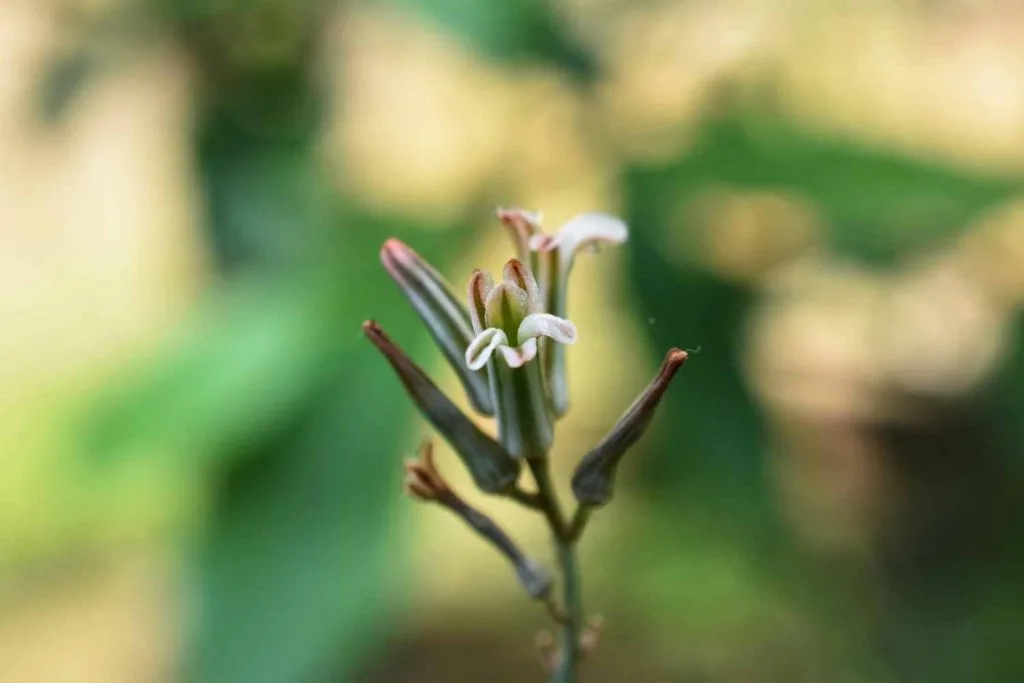
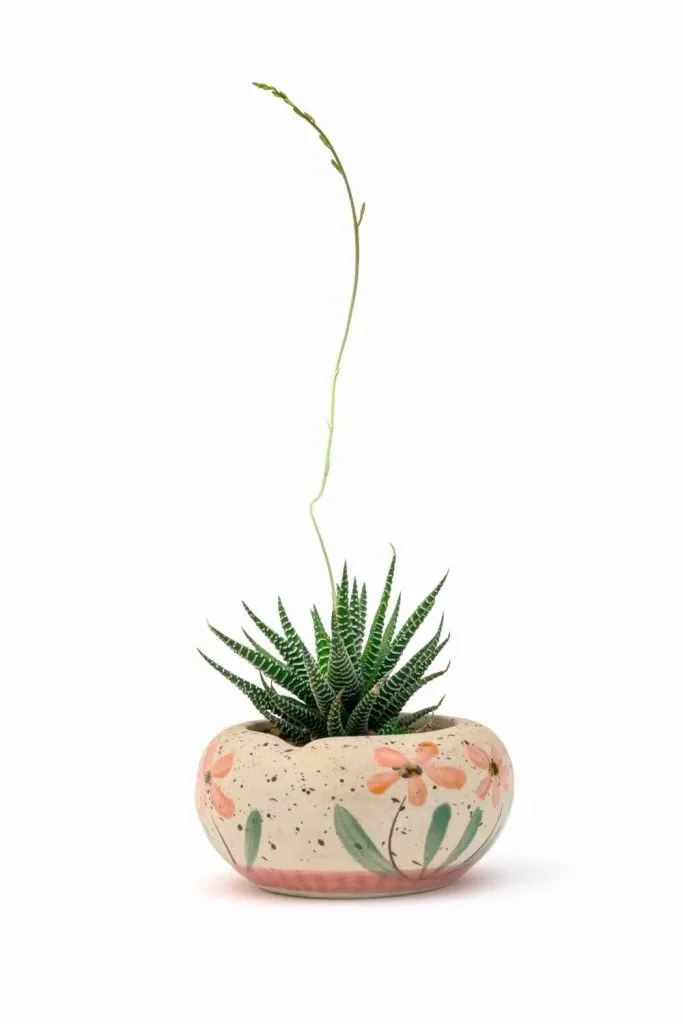
Haworthiopsis normally flower at the end of summer.
How to Propagate Zebra Plants:
There are three simple ways to propagate Zebra Plants:
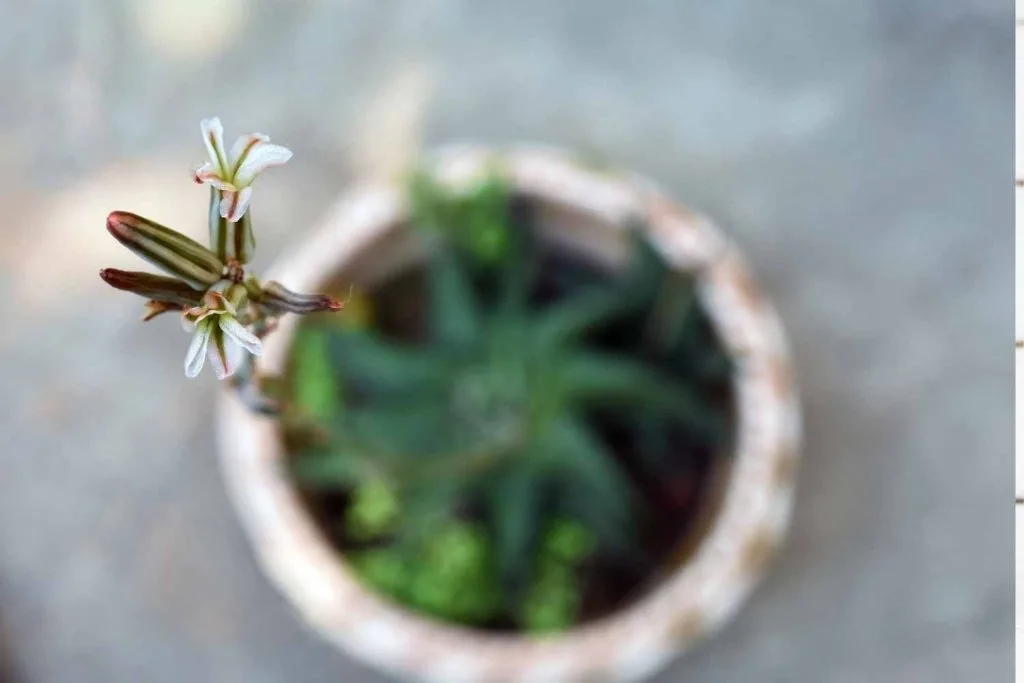
- Flower: The Zebra plant flower grows from a long stem sent up from the plant. Flowers are small and understated. The flower stalk may grow more plant babies. You can cut them off the stalk and replant. Note: Flowers rarely occur indoors.
- Offsets: The zebra plant will naturally grow new plants off the sides of the side of the mother plant. These are called offsets. You can separate the offsets and plant them in a pot by themselves or in another area of your yard if you wish.
- Stem cutting: Pull off a leaf and let it dry (heal over). The next day, plant the healed leaf into moist soil. Keep the soil moist until the plant leaf starts to show new growth.
Growing Haworthiopsis attenuata Outdoors:
The Zebra Haworthiopsis is cold hardy down to freezing which makes it a candidate for growing outdoors in climate zones 10a to 11b. In the correct conditions listed below:
- This plant is a succulent. It requires a VERY well draining sandy soil.
- Zebra plant will thrive outdoors in high humidity but the soil must be allowed to completely dry before watering. Sustained wet conditions will cause root rot and fungus problems.
- Keep your zebra plant in light shade outdoors or dappled light. Strong, intense sunlight for long periods will cause sunburn. The leaves will bleach and discolor.
- Fertilize once with a slow release fertilizer in spring.
- This is a good candidate for growing outdoors in all climate zones as a container plant. When the temperatures drop towards freezing bring the container in for the winter months.
Does Haworthia Need Sunlight?
The Zebra Haworthia plant needs INDIRECT sunlight for best growth. Place this cutie in a bright indirectly lit area of your yard, patio, window sill or shelf with good air flow to see it thrive.
This small succulent plant is somewhat flexible in its lighting needs. it’s not really fussy about light. But the lighting will impact how well it grows.
This plant, like the Haworthia Cooperi, tolerates low light. Keep in mind, the Zebra plant grows very slowly in lower light. In low light they require much less watering.
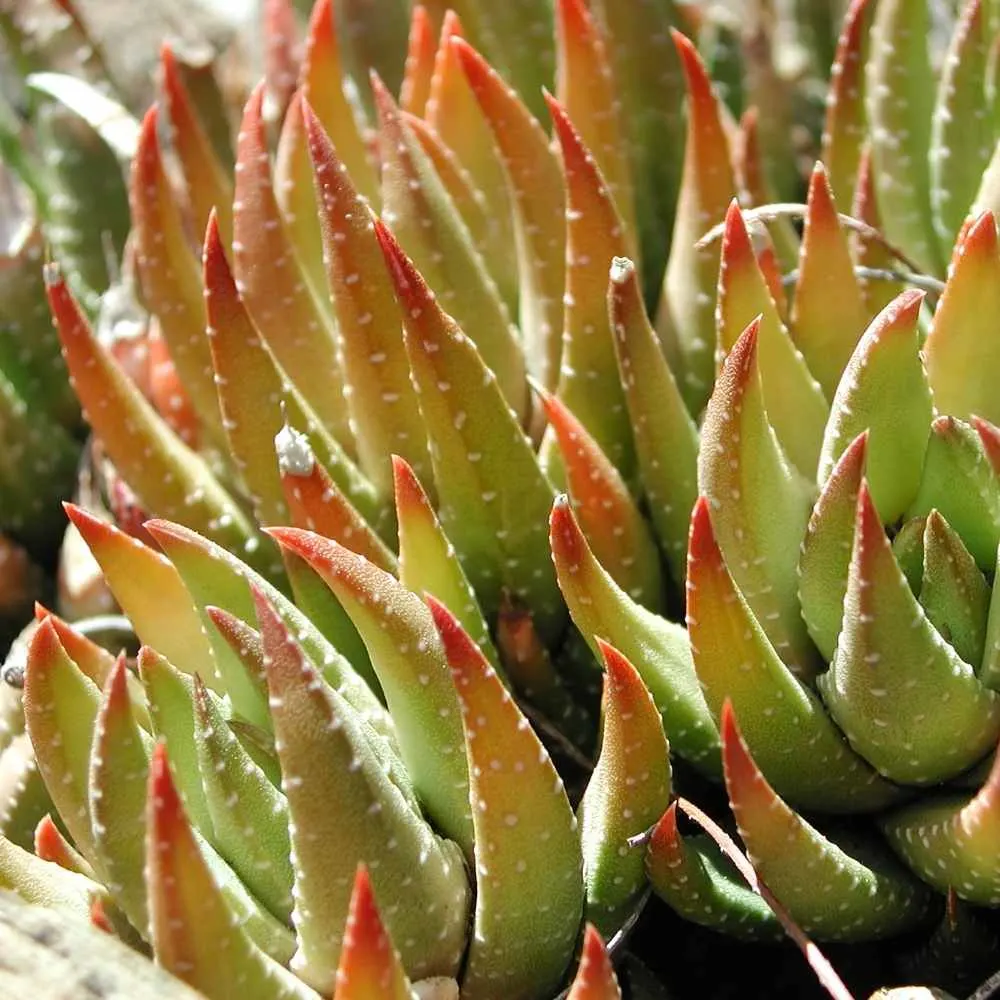
Not all succulents love intense hot sunlight.
Zebra Haworthiopsis bleaches and develops red tips in sustained intense direct sunlight. In succulent circles this is referred to as succulent sunburn.
Jade plants and Snake plants are also susceptible to sunburning. Keep Zebra plants, snake plants and Jade plants in Indirect light for the best colorings.
How Do you Take Care Of Zebra Haworthia Indoors?
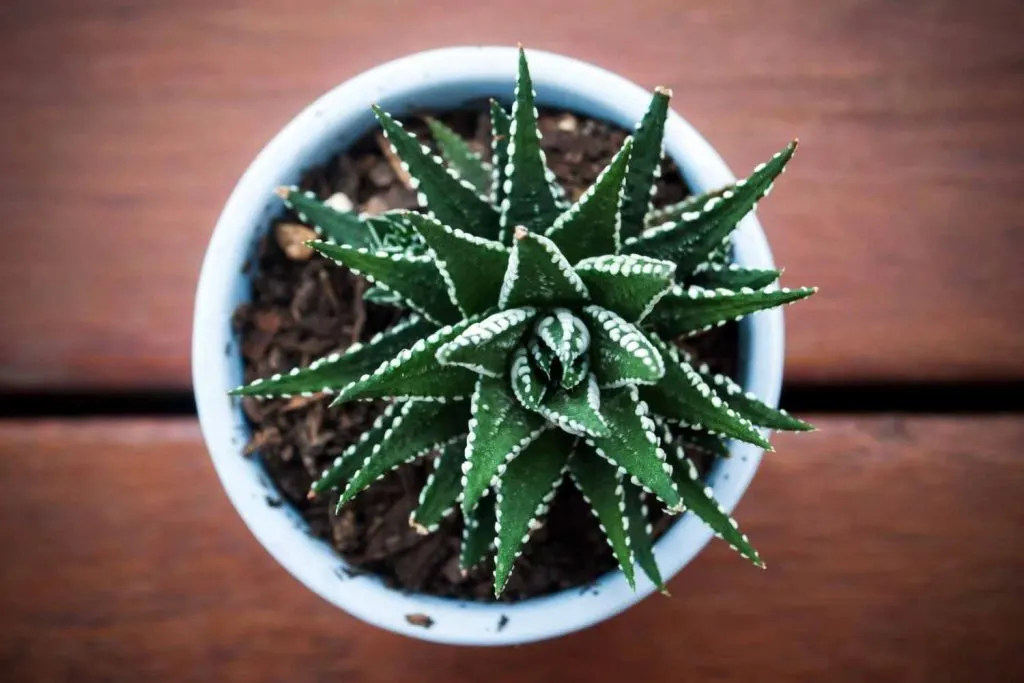
The Zebra Haworthia is a very easy houseplant to take care of if you give it what it needs. This is one of the plants we highly recommend for gifting to beginner plant parents. Our simple guide for beginner Plant Parents offers lots of great advice to get them started.
Here is our quick ‘at a glance’ guide to taking care of the Zebra Plant. For a more in depth and detailed care guide for this particular succulent we’ve included a printable care guide below this quick guide as well.
| Familiar Names: | Zebra plant, Zebra Haworthia |
| Scientific Name: | Haworthiopsis attenuata, (formerly in Haworthia genus) |
| Plant Family: | Asphodelaceae |
| Care Difficulty: | easy |
| Temperature: | 30 to 85 degrees F. |
| Watering: | Water Zebra Haworthia when the soil in the pot is completely dry. these succulents are drought resistant. |
| Soil: | succulent or cactus soil works well for the Zebra plant. |
| Lighting: | Indirect bright light is ideal for Haworthiopsis attenuata |
| Growth: | The Zebra Haworthia grows in small spiny, bushy clumps. |
Your Printable Zebra Plant Indoor Care Guide:
Below is your printable care guide. Learn all about caring for this succulent indoors and how to propagate it too.
Zebra Plant Care Guide
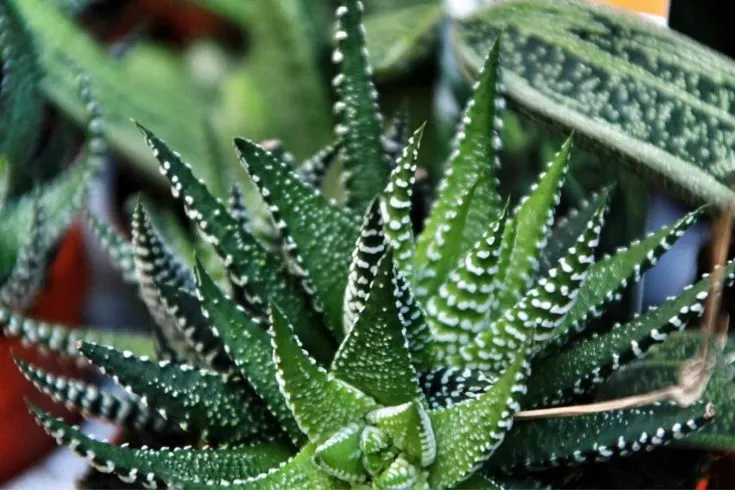
Haworthiopsis varieties are a small succulent commonly known as the Zebra plant.
This plant has long fleshy pointed leaves with tubercles on all or part of the leaves in a pattern reminiscent of Zebras. They grow in a rosette pattern.
This Care Guide will teach you how to keep this houseplant happy all through the year.
Materials
Tools
Instructions
Soil Preference:
- Zebra plants prefer a well draining cactus soil mix. The roots will rot quickly if they sit in moist soil.
- A mix of cactus potting mix and perlite will keep the roots happiest.
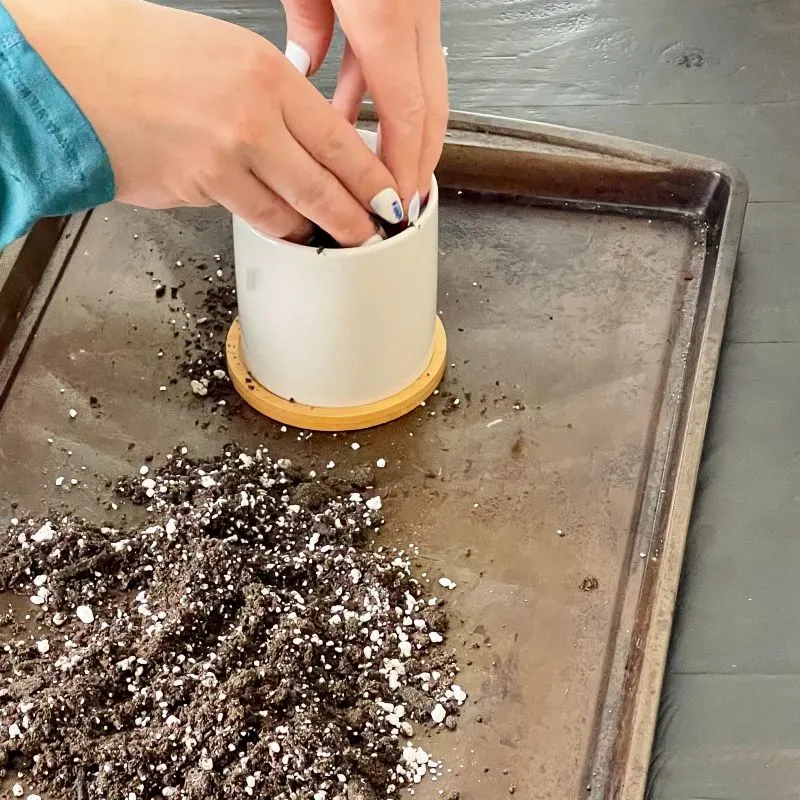
- Make sure your pot has drainage at the bottom. Do not use a pot with no drainage hole for this plant.
- A heavy soil potting mix is not recommended for Zebra plants.
Pot Size and Type:
- The Haworthiopsis can grow in many different kinds of pots, I like to plant mine in ceramic pots with a drainage hole. I linked an Amazon page of adorable cactus pots above for you.
- Repot every second year or when roots come out the drainage holes on the pot bottom To the next pot size up. Don't jump to a huge pot from a small one. Just go to the next size up pot.
Lighting:
- Zebra plants will grow best in bright indirect light.
- Zebra plants will tolerate lower light but will grow very slowly and need much less water.
- If this plant receives too much direct light the leaves may start to change to a red color. This is a stress color. Put your plant is a less intense light.
Watering:
- Water Zebra plants when the soil is dry. These plants are typically drough resistant and can withstand longer periods of dryness compared to other houseplants.
- Watering is best done by drenching the plant thoroughly. Allow the water to run through the pot and then let it drain so no water sits in the bottom drain plate.
- Do not allow water to sit in the center of the leaves and accumulate.
- The recommendation watering cycle is every 2-3 weeks.
- Never let this plant get wet feet. Overwatering encourages root rot and fungus gnats.
How to Fertilize:
- Apply a good quality fertilizer (linked in materials) diluted by 50% once or twice in the summer months. Zebra plants do not need much fertilizer.
- Allow the Zebra plant to rest through the winter months.
Temperature:
- The Zebra plant will do best in temperatures between 30-85 degrees F. For this reason they can grow outdoors in climate zones 10a to 11b.
Pests:
- Zebra plants are hardy resilient plants. However all plants can get attacked by pests.
- Stress by longterm overwatering, poor light, extreme temperatures and soil conditions are contributors to plant stress..
- Spider mites, mealy bugs, scale, thrips and whitefly are the most common houseplant pests you will see. Read our post on the seven most common pests and how to control them here.
- Read our post on How to get rid of aphids and other pests with our homemade pesticide soap recipe or neems oil.
- To minimize the possibility of pests be sure to check all nursery plants before bringing them home.
- Quarantine all new plants until you are sure no pests live in them.
How to Propagate by stem cutting:
- Pull stem off the plant and let it dry for several hours to overnight.
- Plant it in a small pot in wet cactus soil.
- After several weeks roots will grow and settle the new plant.
How to Propagate by flower (most often outdoors):
Sometimes flowers will produce baby zebra plants. These can be snipped off the flower stalk and potted separately to make new zebra plants.
How to Propagate by Offsets:
- Zebra plants naturally grow new plants around their outer perimeter. These are called offsets.
- You can easily unpot your zebra plant and pull the offsets off the mother plant.
- Repot all the offsets in separate pots in cactus soil.
- Water thoroughly. They should be rooted.
Notes
The Zebra Plant is a rewarding and perfect plant for a beginner succulent parent. This plant will grow beautifully with just a little bit of care.
TIP: This plant loves air flow. Don't group it with a lot of other humid loving plants. An open window nearby with warm dry air will keep it happy through the warm months.
More Easy Care Succulent Plants:
There are SO many plants that are great for home decor. But not a lot of fuss. Here are three easy care succulents you are sure to enjoy.
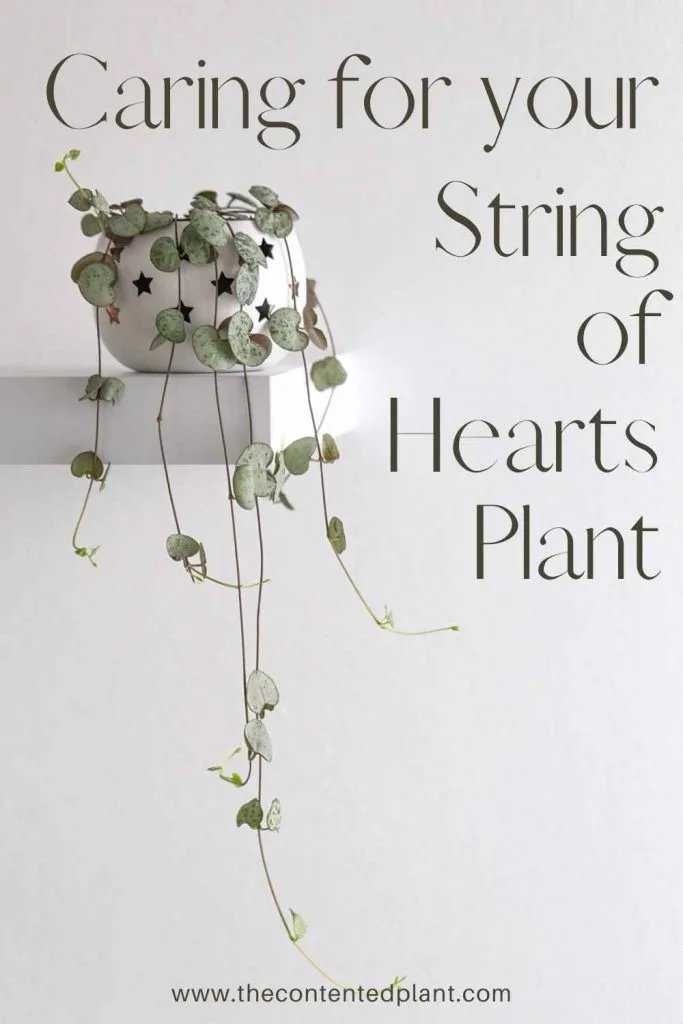
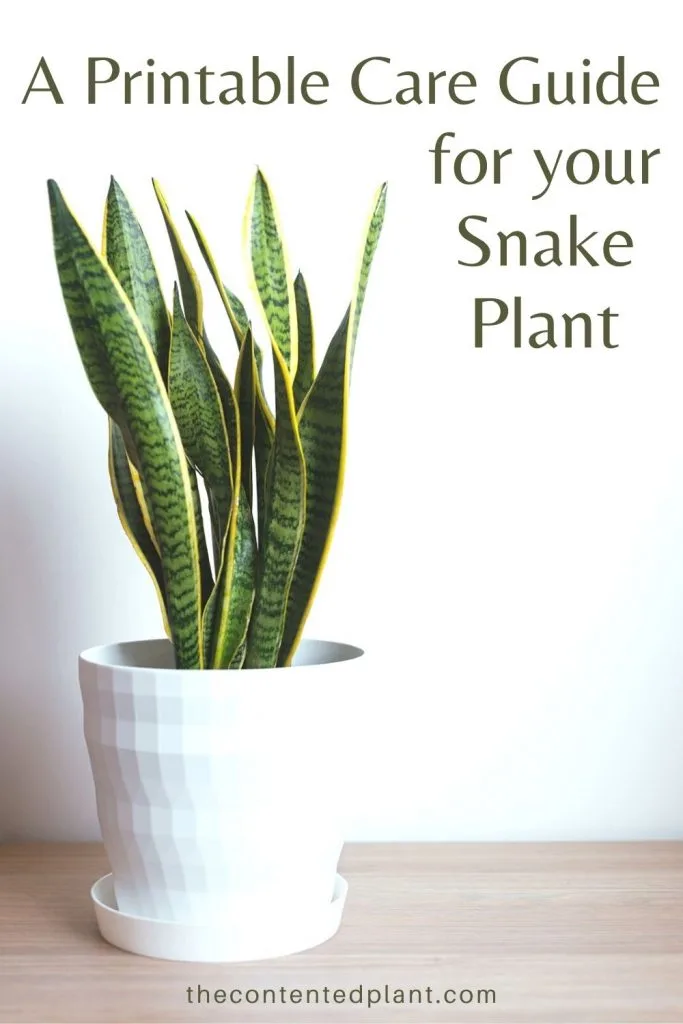
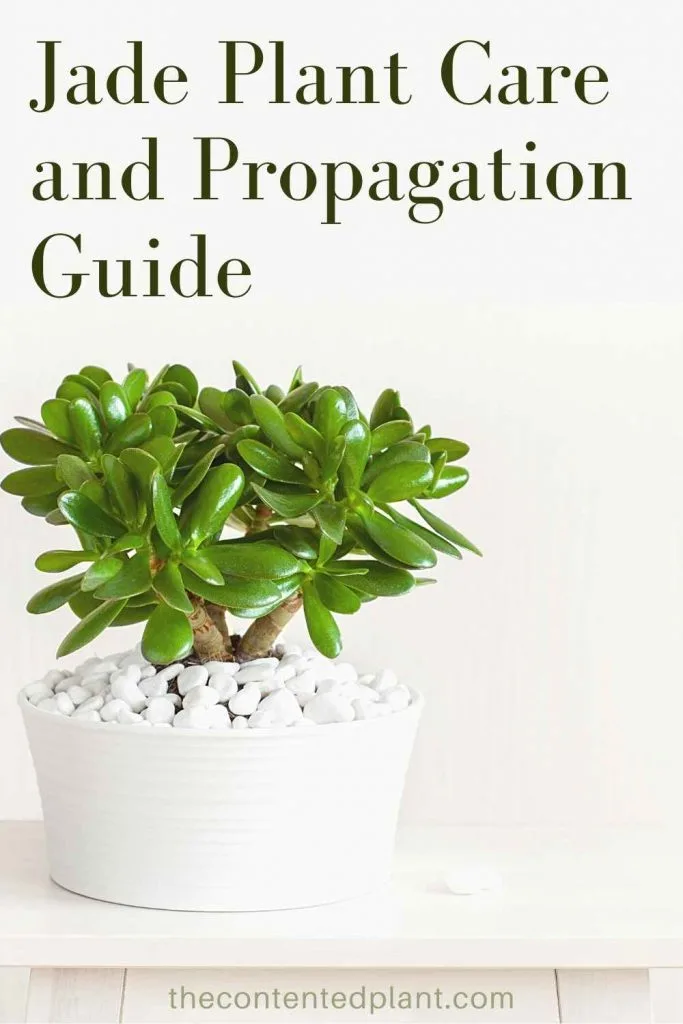
Related Content:
Follow Us:
Find us on YouTube, Instagram , Pinterest and TikTok! We love to Plant chat. We also comment, like and occasionally share your content to our daily stories. We’d love to see your plants. Share your joy in your houseplants. Happy Planting!
Recent Posts:
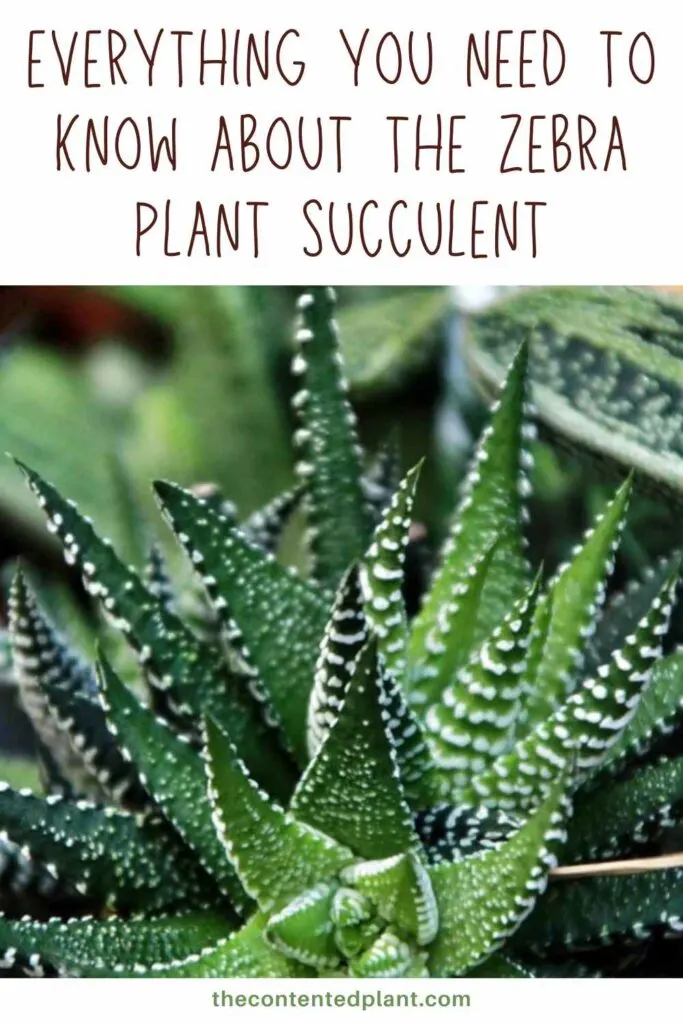
Read more on the Haworthiopsis
Read this article for more on the Haworthiopsis Taxonomy

Watering Plants Properly - The Contented Plant
Wednesday 5th of October 2022
[…] Some houseplants will tolerate almost any water. Pothos, snake plants, zebra plants, asparagus fern, peace lily and Ficus Benjamina all live at my house and tolerate my well water […]
How to Keep your Houseplants Alive In Winter - The Contented Plant
Tuesday 27th of September 2022
[…] tropical plants, All Calatheas for example but even some succulents like the Zebra Plant, will suffer brown tips on their […]
Jade Plant Care and Propagation - The Contented Plant
Friday 6th of May 2022
[…] sunburn can also happen to the Zebra Plant. These succulents do not need super intense […]
Watering Succulents-Tips for Success - The Contented Plant
Friday 14th of January 2022
[…] a moisture meter in one hand and my watering can in the other. That meter needs to say DRY or my Zebra Haworthia is left […]
Variegated String of Hearts Vine - The Contented Plant
Sunday 8th of August 2021
[…] The Zebra Plant (Haworthiopsis) […]